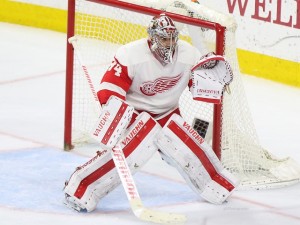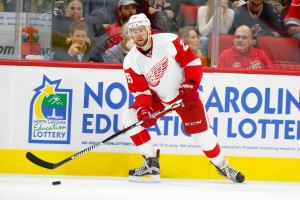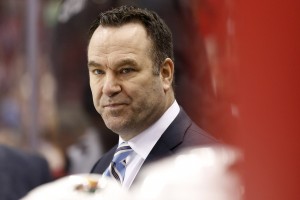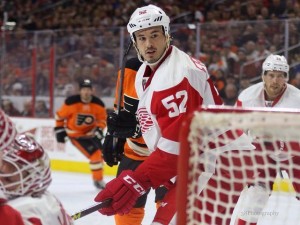After two losses to open the 2016-17 season, the Detroit Red Wings rattled off six straight wins to jump to the top of the standings. After a pair of losses this past weekend, Detroit is 6-4-0.
The team has shown inconsistency — namely in being able to play a full 60 minutes — but it also has shown promise in certain areas. Which aspects have been the most impressive? The Grind Line discusses what has stood out the most during the first 10 games of the season.
Tom Mitsos: Goaltending

For a team that has lost nearly as many games as it has won, goaltending usually wouldn’t be at the top of the list of impressive aspects. However, the Red Wings goaltenders have given their team a chance to win every game. Even in the team’s first two losses — a 6-4 loss to Tampa Bay and a 4-1 loss to Florida — Petr Mrazek kept his team in the game as long as he could, and the score could have been worse if not for him making key saves. Jimmy Howard stole a game against the New York Rangers in his first start and shut out the San Jose Sharks in his second start.
As of Monday morning, the Red Wings are fourth in the NHL in five-on-five score-adjusted save percentage at 94.40, according to Corsica. Howard has a 97.30 five-on-five save percentage in three games, and Mrazek has a 93.04 save percentage in seven games.
The tweet below shows how Mrazek and Howard stack up to the rest of the league, courtesy of hockeyviz.com’s Micah Blake McCurdy.
Eddie, buddy, come back, eh? pic.twitter.com/yyeokKtyR0
— Micah Blake McCurdy (@IneffectiveMath) October 31, 2016
Howard has a perfect four-on-five save percentage, and an unheard of five on five save percentage. Mrazek is closer to the NHL average but still putting up solid numbers. Howard also is the only goalie —of those who have played at least 100 five on five minutes — who has a 100 high-danger save percentage, saving all 16 high-danger shots. Of course, this is a perfect stat that is not sustainable, but it’s impressive how clutch he has been in the early going.
Tony Wolak: More Offense from the Defense

This past season, the Red Wings had tremendous difficulties getting offense from the blue line. Newly signed Mike Green led Detroit defensemen with seven goals and 35 points in 74 games. Danny DeKeyser had the most goals among the Red Wings’ defensemen with eight.
Now, ten games into the 2016-17 season, Detroit’s blueliners have been impressive by contributing more in the offensive zone. Green, DeKeyser and Ryan Sproul have done a fantastic job getting pucks through from the point, leading to more Red Wings goals. Through 10 games, Detroit defensemen have accumulated five goals and 18 points.
In addition to putting more shots on net, Red Wings defensemen also have been more engaged in the rush up ice. Green, Brendan Smith and Xavier Ouellet have been counted on to join the play, creating more odd-man rushes in Detroit’s favor. Even Jonathan Ericsson is (successfully) joining the rush up-ice — his ability to skate past San Jose defenders directly led to Gustav Nyquist’s goal last weekend.
If Detroit’s defense can continue to help facilitate offense and shore up their play in the defensive zone, the Red Wings will remain near the top of the Atlantic Division standings.
Jacob Messing: The Power Play

The Wings closed the 2014-15 season with the second-highest power-play percentage, converting on 23.8 percent and scoring a league-high 70 goals on the man advantage.
The 2014-15 season was of course Mike Babcock’s last with the team, and when he left, he took his assistant coaches with him, including Jim Hiller who ran the team’s successful power play.
Last season, the Red Wings promoted Grand Rapids Griffins coach Jeff Blashill to take over for Babcock and hired Western Michigan University coach Pat Ferschweiler to oversee the offense and power play.
Ferschweiler’s power-play strategy that made his Broncos team successful wasn’t as effective at the NHL level and had 18.8 percent success rate. The team scored 20 fewer goals than the previous season and finished with the 13th-best power play in the league.
The team revamped the coaching staff this summer, announcing Tony Granato would return to his alma mater as the head coach of the Wisconsin Badgers. They opted not to renew long-time goalie coach Jim Bedard and would use Ferschweiler as an “eye in the sky” to have a perspective from the press box.
They brought in 10-year veteran defensive coach Doug Houda from the Boston Bruins and long-time offensive coach John Torchetti, who ended the 2015-16 season as the interim head coach of the Minnesota Wild.
Torchetti’s power play has been refreshing and got off to a hot start with six power-play goals through the teams’ first five games. The team was pressuring opponents, cycling well and taking shots for once.
The next four games saw the Wings come up empty handed on the power play with no goals in 21 power-play opportunities, before scoring two more PPGs against the Panthers in a losing effort.
Assuming the team can make that 0-for-21 slump their worst of the season, the team could be poised for a revitalized power play this season under Torchetti.
Brandon Peleshok: Clear Roles for Players

Ten games into the 2016-17 season, and it would appear Blashill has a much clearer approach to giving his players well-defined roles. Minor injuries to Justin Abdelkader and Thomas Vanek have forced the team to make some adjustments, but for the most part, the Wings have deployed the same players on each special teams unit.
Up front, the Red Wings have used the same eight forwards on the power play all season, along with Helm filling in for the aforementioned injured players. On the penalty kill, the Wings have stuck with Luke Glendening and Drew Miller on one unit, and Frans Nielsen and Darren Helm on the other. When in the lineup, Steve Ott has received some time on the penalty kill, too. While there are a few exceptions, Blashill has done a much better job balancing the time on ice per game for his players this year. It is a different look than last season, where Blashill leaned a little too heavily on some of his veteran forwards.
Roles are clear on the Red Wings’ blue line, as well. Looking at the power play, Green is the team’s clear-cut anchor on the first unit, with Ryan Sproul manning the point on the second unit. On the penalty kill, Blashill has rolled out the same two pairs of defensemen, using DeKeyser and Alexey Marchenko together on one unit and Smith and Ericsson on the other. Niklas Kronwall’s return to the lineup could cause some changes, but for now, Green’s increased role for the Wings and a reduction in Ericsson’s time on ice have worked out well.